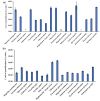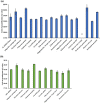Versatile DNA extraction from diverse plant taxa using ionic liquids and magnetic ionic liquids: a methodological breakthrough for enhanced sample utility
- PMID: 38877523
- PMCID: PMC11177442
- DOI: 10.1186/s13007-024-01217-z
Versatile DNA extraction from diverse plant taxa using ionic liquids and magnetic ionic liquids: a methodological breakthrough for enhanced sample utility
Abstract
Background: There is a growing demand for fast and reliable plant biomolecular analyses. DNA extraction is the major bottleneck in plant nucleic acid-based applications especially due to the complexity of tissues in different plant species. Conventional methods for plant cell lysis and DNA extraction typically require extensive sample preparation processes and large quantities of sample and chemicals, elevated temperatures, and multiple sample transfer steps which pose challenges for high throughput applications.
Results: In a prior investigation, an ionic liquid (IL)-based modified vortex-assisted matrix solid phase dispersion approach was developed using the model plant, Arabidopsis thaliana (L.) Heynh. Building upon this foundational study, the present study established a simple, rapid and efficient protocol for DNA extraction from milligram fragments of plant tissue representing a diverse range of taxa from the plant Tree of Life including 13 dicots and 4 monocots. Notably, the approach was successful in extracting DNA from a century old herbarium sample. The isolated DNA was of sufficient quality and quantity for sensitive molecular analyses such as qPCR. Two plant DNA barcoding markers, the plastid rbcL and nuclear ribosomal internal transcribed spacer (nrITS) regions were selected for DNA amplification and Sanger sequencing was conducted on PCR products of a representative dicot and monocot species. Successful qPCR amplification of the extracted DNA up to 3 weeks demonstrated that the DNA extracted using this approach remains stable at room temperature for an extended time period prior to downstream analysis.
Conclusions: The method presented here is a rapid and simple approach enabling cell lysis and DNA extraction from 1.5 mg of plant tissue across a broad range of plant taxa. Additional purification prior to DNA amplification is not required due to the compatibility of the extraction solvents with qPCR. The method has tremendous potential for applications in plant biology that require DNA, including barcoding methods for agriculture, conservation, ecology, evolution, and forensics.
Keywords: Ionic liquids; Magnetic ionic liquids; Matrix solid phase dispersion; Miniaturization; Plant DNA isolation; Sequencing; qPCR.
© 2024. The Author(s).
Conflict of interest statement
The authors declare no competing interests.
Figures





Similar articles
-
Isolation of DNA from plant tissues using a miniaturized matrix solid-phase dispersion approach featuring ionic liquid and magnetic ionic liquid solvents.Anal Chim Acta. 2023 Mar 8;1245:340858. doi: 10.1016/j.aca.2023.340858. Epub 2023 Jan 19. Anal Chim Acta. 2023. PMID: 36737141
-
Development of an innovative and sustainable one-step method for rapid plant DNA isolation for targeted PCR using magnetic ionic liquids.Plant Methods. 2019 Mar 9;15:23. doi: 10.1186/s13007-019-0408-x. eCollection 2019. Plant Methods. 2019. PMID: 30899320 Free PMC article.
-
Simple and efficient isolation of plant genomic DNA using magnetic ionic liquids.Plant Methods. 2022 Mar 24;18(1):37. doi: 10.1186/s13007-022-00860-8. Plant Methods. 2022. PMID: 35321738 Free PMC article.
-
Green aspects, developments and perspectives of liquid phase microextraction techniques.Talanta. 2014 Feb;119:34-45. doi: 10.1016/j.talanta.2013.10.050. Epub 2013 Oct 29. Talanta. 2014. PMID: 24401382 Review.
-
Chiral Ionic Liquids: Structural Diversity, Properties and Applications in Selected Separation Techniques.Int J Mol Sci. 2020 Jun 15;21(12):4253. doi: 10.3390/ijms21124253. Int J Mol Sci. 2020. PMID: 32549300 Free PMC article. Review.
Cited by
-
Optimizing a modified cetyltrimethylammonium bromide protocol for fungal DNA extraction: Insights from multilocus gene amplification.Open Life Sci. 2025 Feb 3;20(1):20221006. doi: 10.1515/biol-2022-1006. eCollection 2025. Open Life Sci. 2025. PMID: 39926474 Free PMC article.
-
Ionic liquid-assisted seed genomic DNA extraction for advanced sequencing applications.Plant Methods. 2025 Jul 16;21(1):97. doi: 10.1186/s13007-025-01417-1. Plant Methods. 2025. PMID: 40665389 Free PMC article.
References
-
- Gostel MR, Kress WJ. The expanding role of DNA barcodes: indispensable tools for ecology, evolution, and conservation. Diversity. 2022;14(3):213. doi: 10.3390/d14030213. - DOI
-
- Gonzalez García E, Ressmann AK, Gaertner P, Zirbs R, Mach RL, Krska R, et al. Direct extraction of genomic DNA from maize with aqueous ionic liquid buffer systems for applications in genetically modified organisms analysis. Anal Bioanal Chem. 2014;406(30):7773–84. doi: 10.1007/s00216-014-8204-y. - DOI - PubMed
-
- Zhang M, Liu Y, Chen L, Quan S, Jiang S, Zhang D, et al. One simple DNA extraction device and its combination with modified visual loop-mediated isothermal amplification for rapid on-field detection of genetically modified organisms. Anal Chem. 2013;85(1):75–82. doi: 10.1021/ac301640p. - DOI - PubMed
Grants and funding
LinkOut - more resources
Full Text Sources

